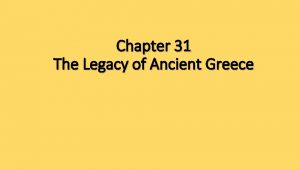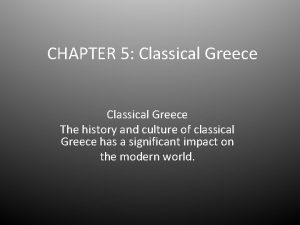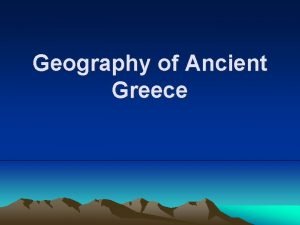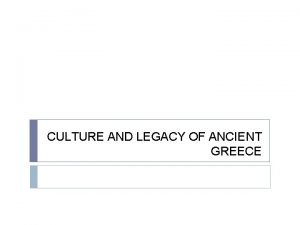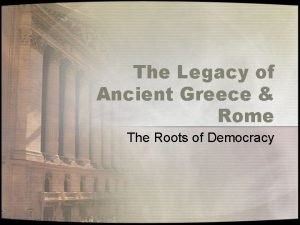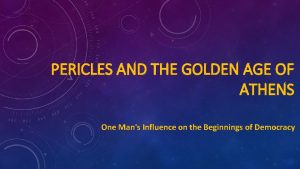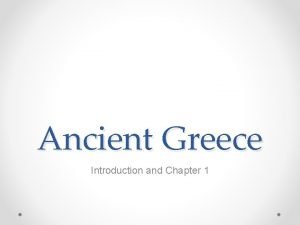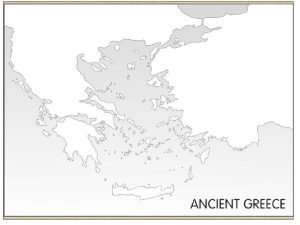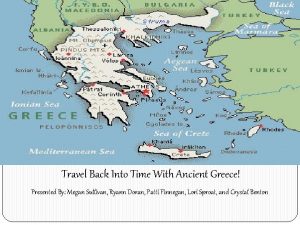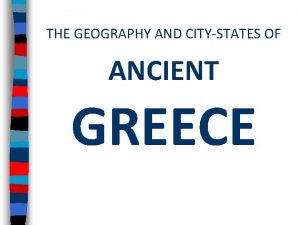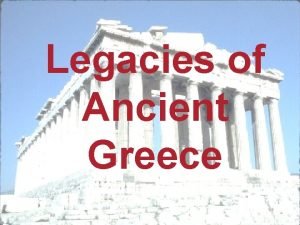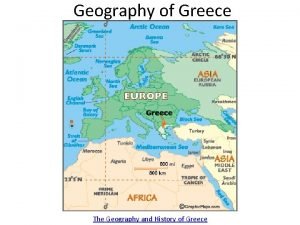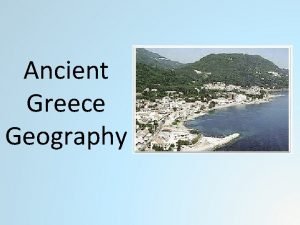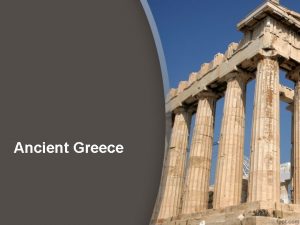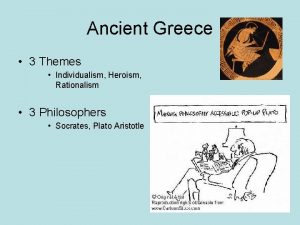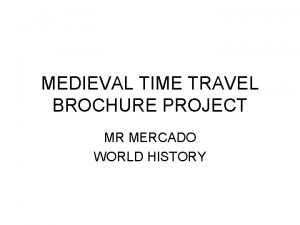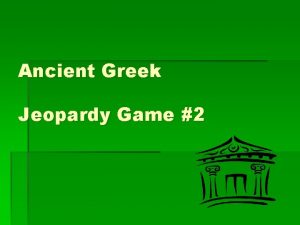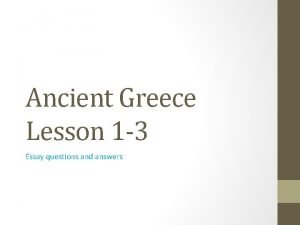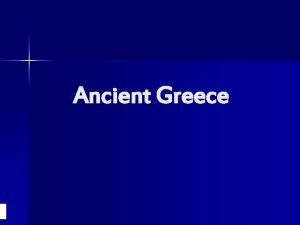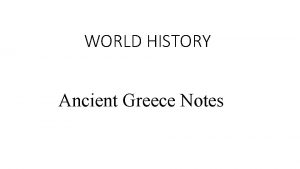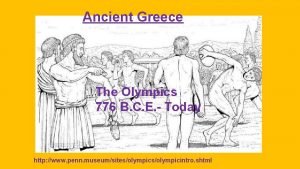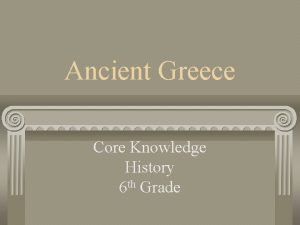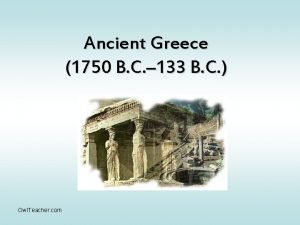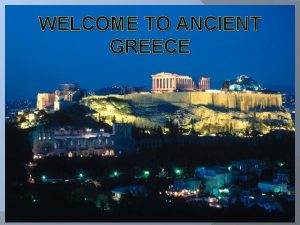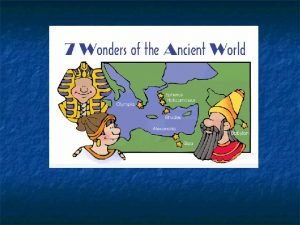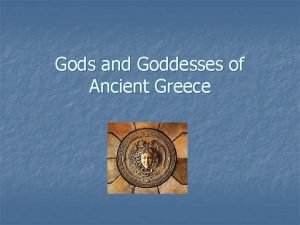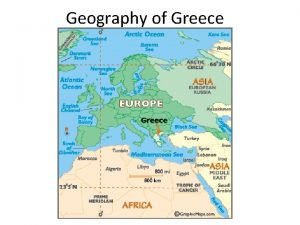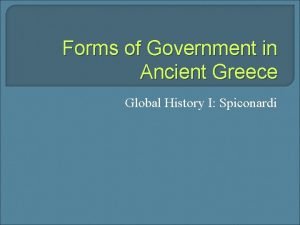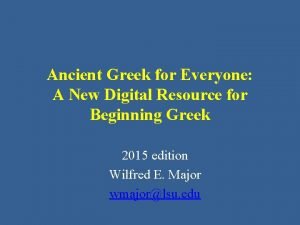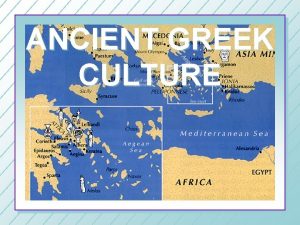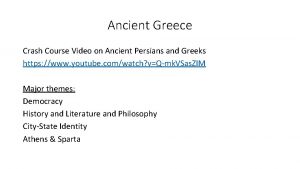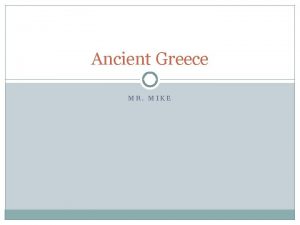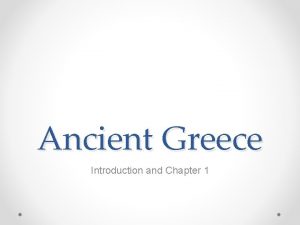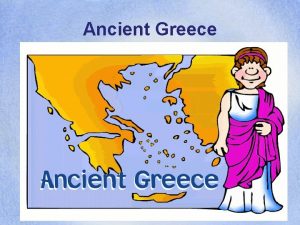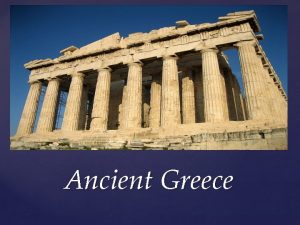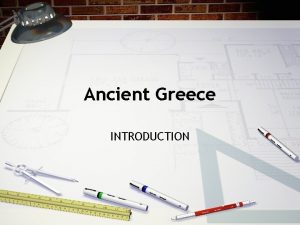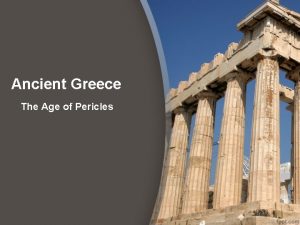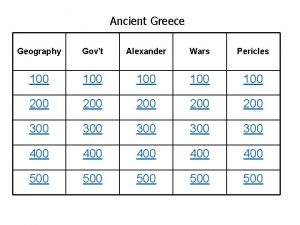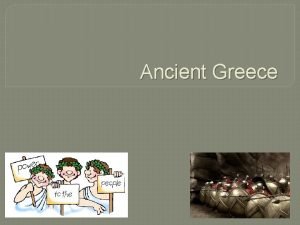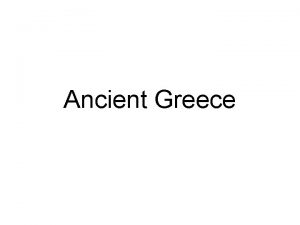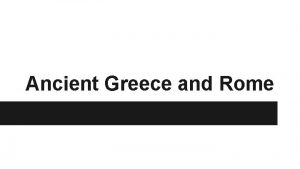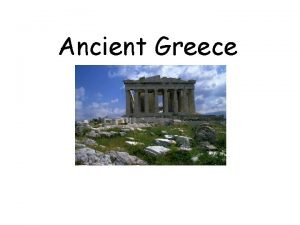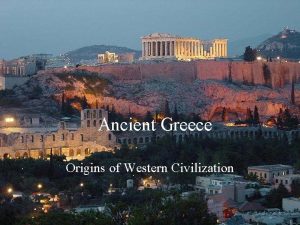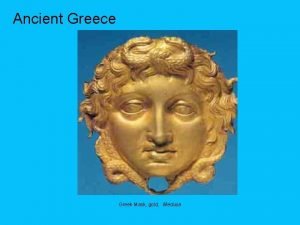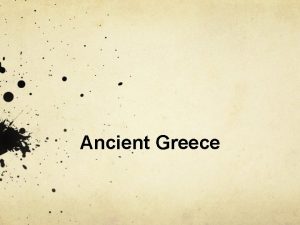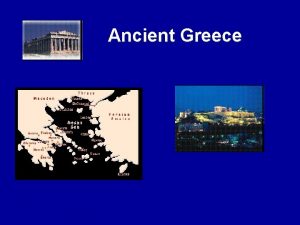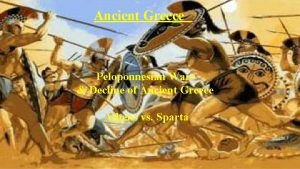Ancient Greece Introduction and Chapter 1 Pericles o










































- Slides: 42

Ancient Greece Introduction and Chapter 1

Pericles o Who was Pericles? o Greek leader who said, “Future ages will wonder at us, as the present age wonders at us now. ” • Ancient Greece has a long history 4, 000 years long!

Greece’s Unique Geography • Greece is a mountainous peninsula in southeastern Europe • Greece is about the size of New York state

Geography • Climate – Most like southern California

Greece’s Two Geographical Areas • What is the Peloponnese? • Hand-shaped Southern area of Greece • Connected to the northern area by the Isthmus of Corinth.

Geography of Greece

Geography • What is the highest mountain in Greece? o Mt. Olympus • Ancient Greeks believed the gods and goddesses lived here

Geography How did the mountainous terrain influence the development of self-government in Greece? Mountains made it difficult to travel from village to village. They were isolated and had to depend on themselves so they had to work together.

A Spirit of Independence Beginnings of Democracy – which means "rule by the people”

Why are the Greek people different? • Very curious people; carefully studied the natural environment. Also supremely confident! o Wondered about the movement of the stars and the life cycles of plants and animals o At first, they thought natural occurrences were the works of supernatural beings – who else thought this way?

Greek People, continued o Over time their observations led to important discoveries in science and math o Also led to the creation of history, philosophy, and psychology

Greek Influence • What are some examples of Greek culture that are readily apparent in our modern world? o Theater o Metaphors like “Achilles’ heel, ” “Pandora’s box, ” and “the face that launched a thousand ships” o Olympic Games o Epics and myths o Architecture

Wrap-Up • Turn to page 5 o Further Thoughts #4 – B. C. /A. D. vs B. C. E/C. E.

Chapter 1 - Crete • Crete o Island to the south of Greece o First part of Europe to be civilized

Minoan civilization arose on the island of Crete.

Early Settlers • First part of Europe to be civilized • Original setters probably mariners from Asia o Lived in caves, then shelters made of mud brick • Settlement around 4000 B. C. E o Neolithic period – “New Stone Age” • Followed the Paleolithic period – “Old Stone Age”

Early Settlers, continued • Grew barley and wheat; later grapevines and olive trees o Wine and olive oil = cash crops

Early Settlers • • • Herded sheep and goats for wool and milk Raised pigs for meat Kept oxen to pull plows Domesticated bees for honey Cypress trees used for wood to build boats

The Development of Trade • Farmers began trading their produce – in turn, they brought back new ideas, food, etc. • Cyprus – Island to the east of Crete o Copper for tools and weapons • Egypt o Traded wine, olive oil, timber, wool, and copper tools for stone vases, gold, ivory, precious stones, faience, ostrich plumes, and linen • Aegean islands o Obsidian

Development of Trade • Potter’s wheel • Merchant ships • Syria o Lapis lazuli , bronze (copper and tin) • Bronze Age • How did history’s first navy develop?

A Powerful Kingdom • Crete grew to have over 100 towns connected by paved roads • Three main cities, each ruled by a king o Knossos o Phaestos o Mallia • In 1600 B. C. E. King Minos of Knossos ruled entire island • Crete was one of the richest empires in the ancient world

The Legend of the Minotaur • Minotaur = monster that is half man and half bull • The Minotaur supposedly lived in a labyrinth below the palace of King Minos • King Aegeus from Athens killed a son of Minos in a battle. Minos wanted revenge!

Legend of the Minotaur • Every nine years (or every year for nine years), seven young men and maidens came as tribute from Athens. These tributes were locked in the labyrinth for the Minotaur to feast upon.

Legend of the Minotaur • When Theseus (a son of Aegeus) learned of the Minotaur and the sacrifices, he wanted to end it. • He volunteered to go to Crete as one of the victims. Upon his arrival in Crete, he met Ariadne, Minos's daughter, who fell in love with him.

Legend of the Minotaur • She promised she would provide the means to escape from the maze if he agreed to marry her. • When Theseus did, she gave him a simple ball of twine, which he was to fasten close to the entrance of the maze. He made his way through the maze, while unwinding the twine, and he came upon the Minotaur.

Theseus and the Minotaur • Theseus and the Minotaur had a fierce battle • He slayed the beast! • Then used the twine to retrace his steps to get out of the labyrinth • He and Ariadne fled to a ship and the curse was over! http: //app. discoveryeducation. com/search? Ntt=theseus

Sir Arthur Evans • British scholar; found some interesting pieces at an antique store in Athens • Went to Crete to investigate further • Found many more stones worn as good luck charms • Bought land in Knossos and began to excavate in 1894

The Palace of King Minos • • Multi-level, many rooms, large staircases, and halls Asymmetrical design – a confusing maze Made of gypsum blocks Palace had plumbing

The Palace • One of the largest cities on Crete was Knossos. A great palace was located there - the Palace of Knossos where the legendary King Minos lived.

The palace had several passageways.

Labyrinth • The palace had a network of paths through which it was difficult to find one’s way. • Labrys means double ax, so labyrinth means “House of the Double Ax”

Works of Art Provide Clues to the Minoan Culture • Minoans were superior craftsmen and artists o Frescoes – pictures painted directly on wet plaster o Griffins – mythical creatures that have the heads of eagles and the bodies of lions o Keftiu – Minoan traders • Egyptians called them “Island People” from across the Great Green Sea

Bull Vaulting • Bull vaulting or bull leaping was both a sport and a religious ceremony. Don’t try this at home!

Fun Fact • Bulls play a major role in many Greek myths about Crete. In one, Zeus disguises himself as a powerful bull and charms a maiden named Europa. He takes her to Crete where they have a son named Minos.

Further Clues Suggest the Power of Knossos • Self-contained village • Many treasures – gold, silver, lapis lazuli • Paid taxes in olive oil (pithoi) Knossos was the center of political and economic power during the height of the Minoan civilization

The Religion of the Minoans • Worshipped many deities o One stands out – snake goddess • What did the snake symbolize? • Why would people worship a snake goddess? • No temples; open air altars • Did the Minoans believe in an afterlife?

The Meaning of the Bulls • Why was the bull so important to the Minoans? o The island lies in a geographical area where earthquakes frequently occur. Earthquakes sound like bulls stampeding. Minoans may have worshiped bulls to appease them.

Discovery of the Minoan Writing • Tablets discovered by Evans contained more than one kind of writing o Oldest had picture writing o Others had a type of script writing – Linear A and Linear B • Michael Ventris o Deciphered Linear B writing o Similar to ancient Greek

Destruction of a Civilization • Massive earthquake on Santorini triggered a volcano. o Triggered a tsunami that caused thousands of Minoans to drown o Ports were destroyed o Royal naval fleet badly damaged o Volcanic ash followed

Fun Fact • A Greek scholar named Plato wrote a story about an island named Atlantis that was populated by a prosperous civilization. One day, the island sank into the sea. Many historians believe Santorini was the island Plato was writing about. • The volcano in the 15 th century BCE blasted the majority of the island away. • Scientists had discovered that Santorini belonged to Crete when they found similar frescoes and tools.

Legacy • Their legacy was as masters of the sea and great shipbuilders. https: //www. youtube. com/watch? v=fji. N 90 z. AUe. E

 Ancient greece contributions
Ancient greece contributions The legacy of ancient greece
The legacy of ancient greece Chapter 5 ancient greece
Chapter 5 ancient greece Greek philosophers of physical education
Greek philosophers of physical education Ancient greece geography map
Ancient greece geography map Culture and legacy of ancient greece stations
Culture and legacy of ancient greece stations The legacy of ancient greece and rome
The legacy of ancient greece and rome Pericles and the golden age of athens
Pericles and the golden age of athens The earliest known grecian epics were written by____ .
The earliest known grecian epics were written by____ . Greece map with labels
Greece map with labels Where was ancient greece located
Where was ancient greece located Romans invade greece
Romans invade greece Legacies of greece
Legacies of greece Where is greece located
Where is greece located Classical greek instruments
Classical greek instruments What did the ancient greeks value
What did the ancient greeks value Which continent is greece located on
Which continent is greece located on Ancient greece geography
Ancient greece geography Athens empire
Athens empire Ancient greece balkan peninsula
Ancient greece balkan peninsula Sparta peninsula
Sparta peninsula Individualism in ancient greece
Individualism in ancient greece Aristotle direct democracy
Aristotle direct democracy Creating a time travel brochure
Creating a time travel brochure Ancient greece jeopardy
Ancient greece jeopardy Ancient greece essay topics
Ancient greece essay topics Is greece a peninsula
Is greece a peninsula Mycenae ancient greece map
Mycenae ancient greece map What did greek actors wear
What did greek actors wear 776 bce
776 bce Core knowledge ancient greece
Core knowledge ancient greece Ancient greece 1750 b.c-133 b.c answers
Ancient greece 1750 b.c-133 b.c answers Ancient greece map quiz
Ancient greece map quiz 7 wonders of ancient greece
7 wonders of ancient greece Ancient greece athens flag
Ancient greece athens flag Zeus siblings
Zeus siblings Greece is where
Greece is where How was tyranny practiced in ancient greece
How was tyranny practiced in ancient greece Aristocrats in ancient greece
Aristocrats in ancient greece Ancient greece olympics opening ceremony
Ancient greece olympics opening ceremony Ancient greece
Ancient greece Humanism in ancient greece
Humanism in ancient greece Ancient greece crash course
Ancient greece crash course

